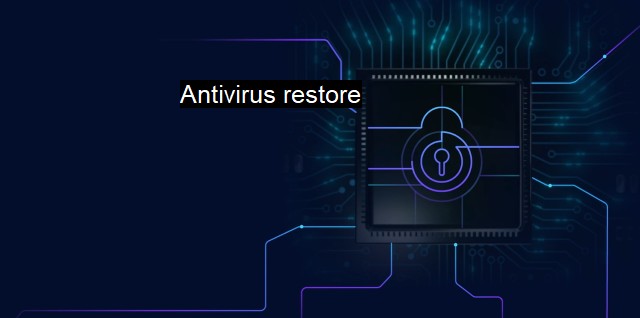What is Antivirus restore?
Antivirus Restore Tools: Safeguarding Your System Against Cyber Threats with Instant Action
Antivirus restore is an important concept in the world of cybersecurity and antivirus. By understanding this term, we can better protect our digital information and our tools from threats and attacks that are proliferating on the web. The antivirus restore process is crucial in combatting and nullifying the negative effects received from the presence of viruses, worms, Trojan horses, keyloggers, and other malicious software, collectively referred to as "malware".The simplest way to understand "antivirus restore" is to break it down into its parts: antivirus and restore. "Antivirus" refers to software designed to detect, prevent, and remove viruses and other malicious software - malware - from computer systems. Meanwhile, "restore" in the world of computing generally means to bring something back to its original condition. When combining these words - antivirus and restore - we get a term that fundamentally refers to the process of returning a system, files, or data to their original condition after they have been infected or damaged by viruses or malware.
Primarily, the role of an antivirus originates from its capability of scanning files, systems, and applications for potential threats. If these threats are found, the antivirus software usually places them in a quarantine area, rendering them harmless by cutting off their ability to spread and cause further harm. The quarantined files can then be individually assessed, repaired or removed to maintain the safety of the system.
In certain situations, there may be false positives where an antivirus software classifies an innocuous file or software as a threat. This may lead to the said file or software being quarantined or even deleted. Antivirus restore allows users to recover these falsely detected files, known as false positives, without causing any harm to their system.
On a more advanced level, antivirus restore can pertain to system recovery after a massive attack or virus infection. For instance, ransomware attacks often lock or encrypt users' files, demanding a ransom for their release. With the right antivirus restore capabilities, a user could negate the encryption and recover the affected files. Similarly, if a virus infection was so severe and pervasive that it caused substantial damage to a user's system, comprehensive antivirus restore could potentially bring the system back to its pre-infection state.
In the current cybersecurity landscape, hackers and threat actors are increasingly employing complex methods of evading detection. Some malicious software even goes a step further and attacks antivirus software directly. Having powerful enough antivirus software and a robust antivirus restore service would thus allow for continuous protection and potential restoration post a severe attack.
It’s also interesting to take note, that as technology advances, antivirus and restore functions are no longer isolated features but are becoming increasingly integrated with other protective mechanisms within security software. Encryption, firewall provision, backup, and restore services, convenient quarantine services, and Anti-Spam features are just some of the additional options provided along with contemporary antivirus software.
To sum up, antivirus restore is a critical feature of cybersecurity measures. Without effective restoration services, the process of quarantining or deleting malware off the system would only cover half the battle - like ‘treating the symptoms and not the disease’. What makes antivirus restore essential is its focus on restoring the balance, on curing the disease and not just pacifying the symptoms - ultimately enabling users to regain their data and return their system to a safe, operational state post a cyberattack or a virus/malware infection.

Antivirus restore FAQs
What is the purpose of antivirus restore?
Antivirus restore is a cybersecurity feature that enables users to recover or restore files, documents, or data that have been affected by malware or viruses.Can I restore files that were deleted by an antivirus program?
It depends on the specific antivirus program you're using. Some antivirus programs move files to quarantine instead of deleting them, and you may be able to restore them from there. However, if the files were permanently deleted, they cannot be restored.Do I need to restore my antivirus settings after a system restore?
Yes, you should restore your antivirus settings after a system restore. This will ensure that your computer is fully protected against viruses and malware. You may also need to update your antivirus program to the latest version.How often should I perform an antivirus restore?
The frequency of antivirus restore depends on your computer usage and the level of threat or virus activity. It is recommended that you perform a full system scan and restore at least once a week, and more frequently if you frequently download files or browse potentially risky websites.| | A | | | B | | | C | | | D | | | E | | | F | | | G | | | H | | | I | | | J | | | K | | | L | | | M | |
| | N | | | O | | | P | | | Q | | | R | | | S | | | T | | | U | | | V | | | W | | | X | | | Y | | | Z | |
| | 1 | | | 2 | | | 3 | | | 4 | | | 7 | | | 8 | | |||||||